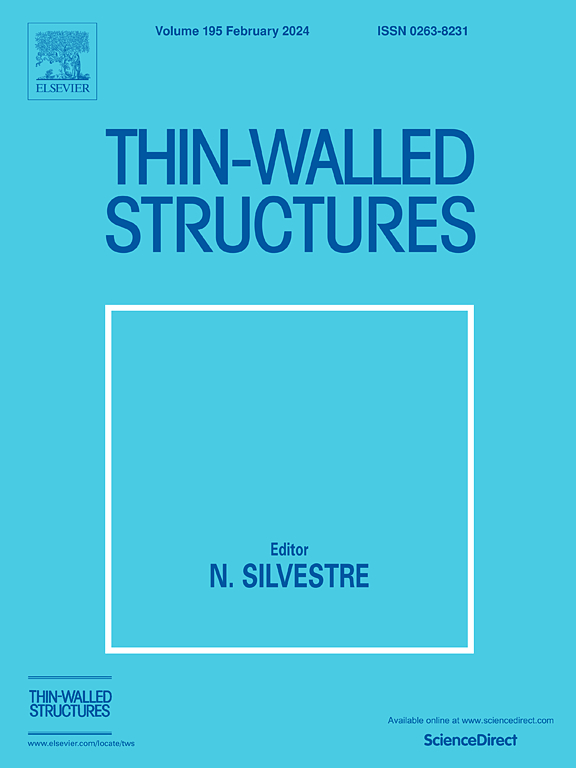热环境下由具有双曲率的功能分级材料组成的薄夹层壳的非线性动力学研究
IF 6.6
1区 工程技术
Q1 ENGINEERING, CIVIL
引用次数: 0
摘要
双曲面结构作为承重部件在各个工程领域都发挥着至关重要的作用。混合了金属和陶瓷的功能梯度材料具有卓越的材料特性,推动了其应用领域的不断扩大。本研究开创性地对热环境下具有功能梯度成分的夹层外壳进行了非线性动态分析。我们假设这些双曲面结构的上下壳体均由功能梯度材料制成,内核为陶瓷。这种材料的变化表现为内表面是陶瓷层,外表面是金属层,其特性沿外壳厚度呈幂律梯度变化。利用三阶剪切理论推导出非线性动态方程,包括几何非线性和剪切变形。采用 Galerkin 方法,我们将运动方程离散化为具有五个自由度的非线性动力系统,随后通过多尺度分析给出了非线性固有频率的分析表达式。我们讨论了结构参数、孔隙率体积分数、体积分数指数和温度差对双曲面夹层壳非线性/线性频率比的影响。计算显示,随着结构长宽比 b/a 的增大,非线性/线性频率比急剧上升,随后迅速下降。相反,随着厚度长度比和半径长度比的增大,非线性/线性频率比会减小,温度差最初会减小非线性/线性频率比,随后会增大非线性/线性频率比。这些发现为设计功能梯度双曲率夹层外壳提供了实用见解。本文章由计算机程序翻译,如有差异,请以英文原文为准。
Investigation of the nonlinear dynamics of thin sandwich shells composed of functionally graded materials with double curvature in thermal environments
Double curvature structures play a crucial role as load-bearing components across various engineering fields. Functionally graded materials, blending metals and ceramics, boast superior material characteristics, fueling their expanding applications. This study pioneers the non-linear dynamic analysis of sandwich shells that feature functional gradient compositions in thermal settings. We assume that both the upper and lower shells of these double curvature structures are crafted from functionally graded materials, with a ceramic core. This variation in material exhibits a ceramic layer on the inner surface and a metallic layer on the outer surface, showing properties that vary along the shell thickness in a power-law gradient. Non-linear dynamic equations are derived using third-order shear theory, encompassing geometric non-linearity and shear deformation. Employing the Galerkin method, we discretize the equations of motion into a non-linear dynamic system with five degrees of freedom, and subsequently give an analytical expression for the nonlinear naturalfrequency by means of multiscale analysis. Our discussion examines the impacts of structural parameters, porosity volume fraction, volume fraction index, and temperature differences on the non-linear/linear frequency ratio of doubly curved sandwich shells. Calculations reveal a sharp rise followed by a rapid decline in the non-linear/linear frequency ratio with increasing structural aspect ratio b/a. Conversely, it decreases with increasing thickness-to-length and radius-to-length ratios, with temperature differences initially reducing and later increasing it. These findings offer practical insights for designing functional gradient double curvature sandwich shells.
求助全文
通过发布文献求助,成功后即可免费获取论文全文。
去求助
来源期刊

Thin-Walled Structures
工程技术-工程:土木
CiteScore
9.60
自引率
20.30%
发文量
801
审稿时长
66 days
期刊介绍:
Thin-walled structures comprises an important and growing proportion of engineering construction with areas of application becoming increasingly diverse, ranging from aircraft, bridges, ships and oil rigs to storage vessels, industrial buildings and warehouses.
Many factors, including cost and weight economy, new materials and processes and the growth of powerful methods of analysis have contributed to this growth, and led to the need for a journal which concentrates specifically on structures in which problems arise due to the thinness of the walls. This field includes cold– formed sections, plate and shell structures, reinforced plastics structures and aluminium structures, and is of importance in many branches of engineering.
The primary criterion for consideration of papers in Thin–Walled Structures is that they must be concerned with thin–walled structures or the basic problems inherent in thin–walled structures. Provided this criterion is satisfied no restriction is placed on the type of construction, material or field of application. Papers on theory, experiment, design, etc., are published and it is expected that many papers will contain aspects of all three.
 求助内容:
求助内容: 应助结果提醒方式:
应助结果提醒方式:


